|
Patchogue
Signal History |
Signals just south of Skillman Ave. at the Montauk Cutoff turnout view N. toward City Storage Bldg. |
|
Patchogue
Signal History |
Signals just south of Skillman Ave. at the Montauk Cutoff turnout view N. toward City Storage Bldg. |
| Train Order (T.O.) Signals | ||
|
This was the
format for a block office to advise a train crew during day or night
hours of operation that the operator had a train order for them to
pick up. The yellow
designated a Form 19 order which was caught on the fly and the red
designated a Form 31 order, meaning the train had to stop and the
Conductor and Engineer had to sign the bottom showing receipt of said
order. What's interesting
is that the LIRR stopped using Form 31 orders around 1926 yet the
official order to annul their use and their respective signalling
appears to have not been done until 1939! Info: Courtesy
of Dave Keller
|
|
|
| Semaphore Signals | ||
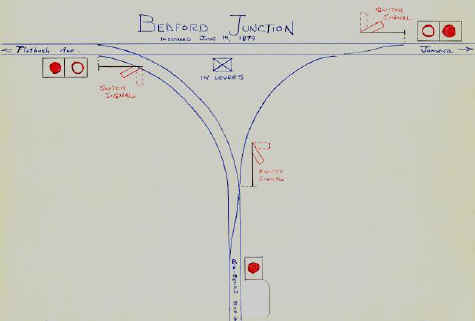 |
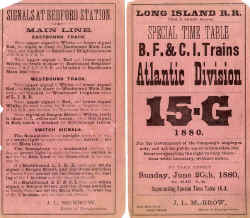 |
|
| Bedford Junction 06/14/1879 The Long Island Rail Road's first interlocking plant and tower were installed on Atlantic Avenue just west of Franklin Avenue. Rather than having the home signal's aspects indicate the position of switches after being displayed for trains, there were separate semaphore switch signals and color home signals. Archive: Art Huneke | LIRR Book of Rules (special Time Table) Atlantic Division 15-G 06/20/1880 Archive: Art Huneke | |
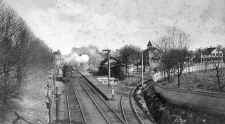 Mineola Station Cutoff to Hempstead Branch c.1890 Archive/Info: Dave Keller
|
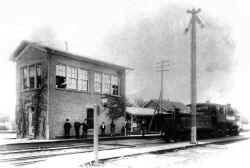 Tower #45: 2 c.1905 Brick tower in service 1890, south of mainline east end of wooden station platform; E of Mineola Blvd. Renamed "MT" 1907 Archive/Info: Dave Keller
|
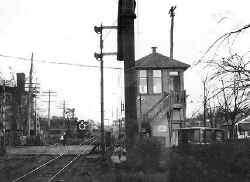 PD Tower 03/18/1930 (James V. Osborne - Dave Keller)
|
|
|
||
|
*
Distant signal indicators (DSI) let the engineer know that there's a signal ahead. |
||
| Position Light Signals | ||
| The Pennsylvania Railroad started experimenting with a radically new signal design in 1915. This signal consisted of rows of yellow lights, in an attempt to simulate the position nature of semaphore signals. The decision to find a new signal followed the start of electrification in 1913, once they found it was difficult to see semaphores thru the catenary wires. | ||
| First use of position light signals in lieu of semaphore signals
on a LIRR branch was at automatic block signal R143 on track 2 east of
Hammel,
Rockaway Beach branch. G.O. #109-11. Eff:5/15/29 in ETT #109, Eff: 10/17/28 Info: Dave Keller |
||
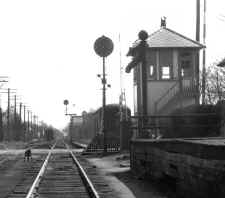 PD Tower 5/1943 Fred Weber photo. Dave Keller archive
|
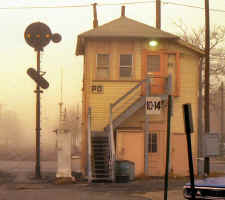 PD Tower c. late 1970's as Train Order Signal added after renovation 1971. Photo: Chris Allen |
Rule
290 RESTRICTED signal indication means to proceed at Restricted Speed
prepared to stop short of train, obstruction or switch not properly
lined and looking out for broken rail, not exceeding 15 MPH.
|
|
A signal's background
helps provide contrast so that an engineman can discern the signal
from other lights at speed and at a This is the case illustrated here in this PRR signal standard diagram: PRR Signal Standards S-400-E and as seen above. Aspects 3 and 5 in the
diagram ("Slow Approach" and "Restricting",
respectively) would both be approached at a reduced speed indication
on the previous signal. However, aspects 6 and 8 ("Medium
Clear" and "Approach Medium", respectively), would be
approached at between 30 mph and track speed. Hence, Note 3 in the
diagram requires the partial background (part number 4012) behind the
vertical lights that would be displayed as part of this aspect. This
is why the signals have the background for the vertical lights, but
not the diagonals. This document shows the new "mostly full" lower background (part number 4013) that was introduced along the way as these new aspects came into play. Once the PRR Paoli Line experiment of using a detached backing was abandoned the setup involved only the Approach Medium Speed (Rule 282) vertical getting a backing because the Approach Slow (Rule 284) and Restricting (Rule 290) positions on the lower head would only be approached at slow speeds, therefore the PRR decided that crews had ample time to sight the unbacked positions. Full lower backings (unverified) came about after Medium Approach (Rule 283a) was adopted in 1956 resulting in higher speeds approaching a lit lower right hand diagonal "flashing" signal. _________________________________________________________________________ Information on the
backgrounds may come from an A.H. Rudd article in the July 1921 issue
of Railway Signal Engineer. There he indicates that a background
was only applied to the vertical row of lights in the lower arm since
those aspects are approached at speed (Approach Medium and Medium
Clear, using their current names). The diagonal and single
marker slow speed aspects (Slow Approach, Restricting, and Stop and
Proceed, using their current names) did not need a background since
long range sighting was unnecessary. The reduced size of the
background and wind pressure area allowed the use of standard sized
signal masts (weight and wind were issues with the early four-light
position signals on masts). |
||
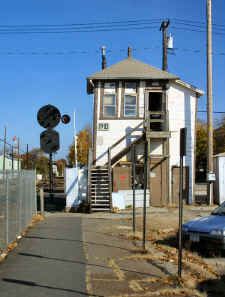 PD Tower 11/05/2000 Photo: Chris Allen |
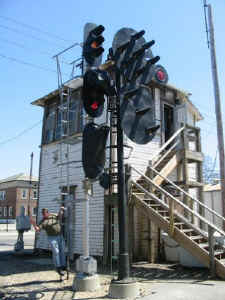 PD Tower 4/29/2006 |
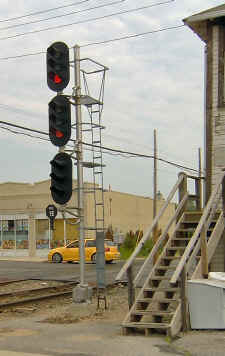 PD Tower Signal c. 8/2006 |
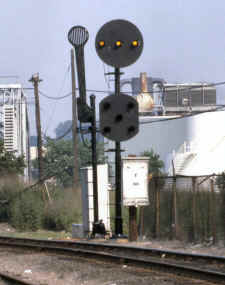 Smashboard and eastbound Signal #006 view SE at Dutch Kills swing bridge 06/1981 Photo: S. Goldstein |
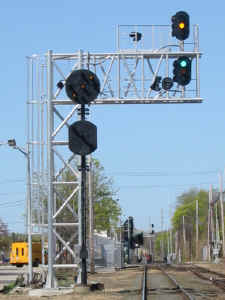 LIRR shortest block? Ocean Ave, Patchogue view W 4/29/2006 Photo: Paul Strubeck |
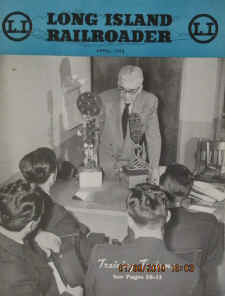 Cover of the Long Island Railroader April 1953 monthly magazine showing a training class on signals for the engineers. Notice on the left you have a high and dwarf PL signal and on the right a pedestal signal. |
| Section Break Signals | ||
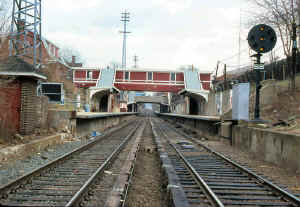 Bayside station and section break (SB) signal looking east - 1/22/79 (Jeff Erlitz photo, Dave Keller archive) |
A Section Break Signal, which also served as an automatic block signal was located at a break in the third rail section. They were designated by the letters "SB" below the signal head and were listed in the Timetable's Special Instructions. Third rail power past the signal could be de-energized. When it was, for an emergency purpose for example, the signal would display Stop aspect. A Section Break Signal displaying Stop could not be passed, as an automatic signal (whose most restrictive aspect was Stop and Proceed) could be. Per retired LIRR block operator
Art Huneke: As long as the power was on, a train passing would put the signal to stop and proceed. With power off, signal would go to "STOP AND STAY" and remain so until power was restored. Per
Jeff Erlitz: |
|
| Brief PRR Position Light Signal History | ||
| 1840’s
The semaphore was patented by John James Stevens. 1871 - Pennsylvania RR absorbs the Camden & Amboy, and block signal installation was completed between Jersey City and Philadelphia. 1882 - The Pennsy installs its first electro-pneumatic lower quadrant semaphores. 1884 - The Pennsy is the first to install an automatic block network utilizing electro-pneumatic lower quadrant semaphores between East Liberty and Wilkensburg PA - by the end of 1884, 65 were in service. 1906 - The first of the three aspect upper quadrant semaphores was installed on the Pennsylvania RR between W Philadelphia and Elwyn PA. 1906-1908 - Research by Corning into lenses and colors, and they came up with the current green-yellow-red, replacing white-green-red. 1913 - The Pennsylvania RR starts electrification. 1914 - Perfection of a concentrated-filament lamp to provide color light signals a satisfactory sighting distance. 1918 - The PRR simplifies the design of their PL signals, eliminating one of the four "heads" for each aspect. 1921 - Pennsy's PL's started taking the shape and configuration were are accustomed to today. |
||
|
Temporary Manual Block Signals (MBS) |
||
|
Bliss Tower, YPD 131 (Yard
Passenger Diesel 131) Jamaica |
I remember seeing a pair up in the old STM office in Jamaica. Usually someone went out prior to them going in service and laid out a buried extension cord, control cable and pipes to accommodate the size of the pipe the sigs were mounted on. They were simply a basic traffic light, 1 red and 1 green light, and they were used for special projects like golf events at SH College (or a temporary station built for the golf event and then removed), Bliss or places like the Oyster Bay. They would take one track out for a period of time, and then the other track would be designated a secondary track for wrong railing and they would have these at some half way point, such as near Glen Head station where they would space out the trains. All of this was done by General Notice and a temporary block station was established at the location. They had pipes in the ground permanently at Bliss, and I'd bring a tent stake to dig out the plastic pellets from when Allied/Triplex was still getting serviced, as that stuff was all over the place. They would route the LI City/Hunterspoint diesels via the Lower Montauk (before the NYA picked it up) to lessen the traffic over the Mainline during big trackwork projects or Amtrak disruptions. Having this saved the crews the headache of trying to get a S-Card, we'd just turn on the green light for Westbounds, and then the red when it was time to go East. A simple switch and that was it. If they were used in the old manual block territory, then you could call them temporary MB signals. Can't think of them being used in the past 10 years, and honestly can't think of an occasion where they would be used again, except in something where you have a big stretch of 251, like the OYB, or Babylon-Y for a big trackwork blitz. Info: "krispy" |
|
|
|
|
|
|
|
||